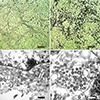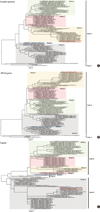Abstract
Figures and Tables
Fig. 1
Cytopathic effects of MERS-CoV in Vero cell cultures and Electron microscopy image of MERS-CoV. Vero cells were inoculated with oropharyngeal swab sample. (A) Vero cell cultures in negative control. (B) Cytopathic effects (rounding and detachment of cells) in Vero cell cultures 3 days after inoculation of the sample. (C, D) Transmission electron microscopy image of Vero cells infected with MERS-CoV. White arrow denotes nuclear membrane. Brown scale bar indicates 100 μm (A and B). Black scale bar indicates 500 nm (C) and white scale bar does 200 nm (D).

Fig. 2
Molecular phylogenetic analysis. Phylogenetic tree on complete genome (A), S genes (B), and ORF1ab genes (C) for the 101 gene sequences of MERS-CoV. The evolutionary history was inferred by using the maximum likelihood method based on the Tamura-Nei model (16). Evolutionary analyses were conducted in MEGA6 (17). Red box indicates our virus isolate.

Table 1
PCR primer pairs used in this study

ACKNOWLEDGMENT
Notes
Funding This work was supported by a grant from the Korean Healthcare Technology R&D Project through the Korea Health Industry Development Institute (KHIDI), funded by the Ministry of Health & Welfare, Republic of Korea (grant number: HI15C3227).
AUTHOR CONTRIBUTION Conception and design: Oh MD, Park WB. Acquisition of data: Park WB, Kwon NJ, Choe PG, Oh HS, Choi SJ, Lee SM. Analysis and interpretation of data: Oh MD, Park WB, Chong H, Kim JI, Song KH, Bang JH, Kim ES, Kim HB, Park SW, Kim NJ. Manuscript preparation: Oh MD, Park WB, Kwon NJ, Choe PG. Manuscript approval: all authors.




 PDF
PDF ePub
ePub Citation
Citation Print
Print



 XML Download
XML Download